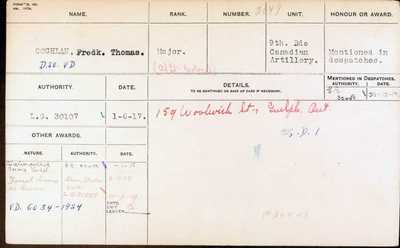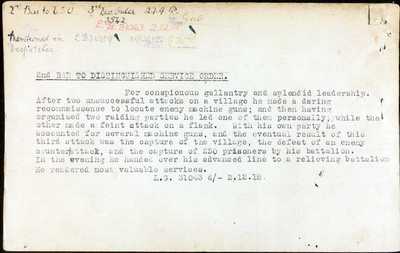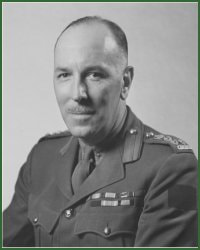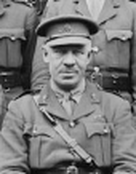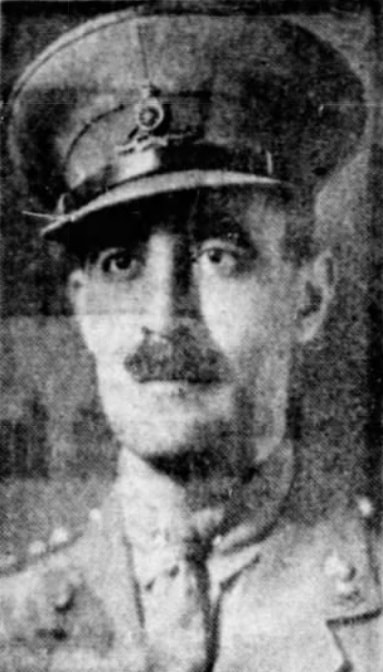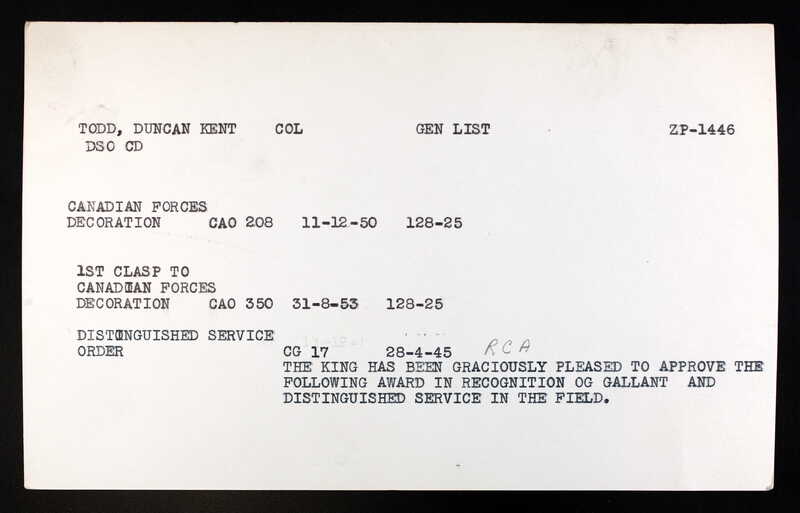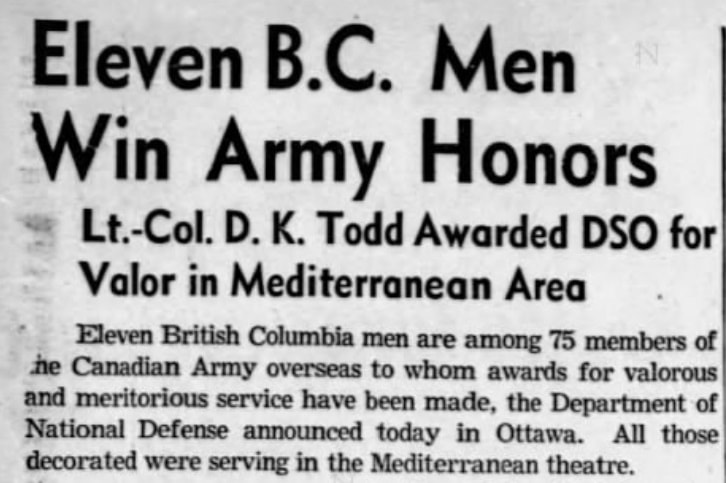as at 25 October 2020

Lieutenant-Colonel Frederick Thomas Coghlan, DSO
Commanding Officer of the 15th Brigade, Canadian Field Artillery from 1920 until 1924.
In 1904 he joined the 11th Battery, 1st Brigade of the Militia Reserve and in June 1915, organized and recruited the 29th Battery, Canadian Field Artillery (CFA). In France, Coghlan commanded the 29th Battery, CFA, at Ypres, the Somme and Vimy. In 1917, Coghlan was promoted to Acting Lieutenant Colonel and Officer Commanding, first the 11th Brigade, and later the 43rd Battery, CFA.
He was awarded the Distinguished Service Order (DSO) for gallantry at Passchendaele and the Croix de Guerre for bravery at Amiens, France. His citation card does not contain any specific information and we continue to look for more details.
Commanding Officer of the 15th Brigade, Canadian Field Artillery from 1920 until 1924.
In 1904 he joined the 11th Battery, 1st Brigade of the Militia Reserve and in June 1915, organized and recruited the 29th Battery, Canadian Field Artillery (CFA). In France, Coghlan commanded the 29th Battery, CFA, at Ypres, the Somme and Vimy. In 1917, Coghlan was promoted to Acting Lieutenant Colonel and Officer Commanding, first the 11th Brigade, and later the 43rd Battery, CFA.
He was awarded the Distinguished Service Order (DSO) for gallantry at Passchendaele and the Croix de Guerre for bravery at Amiens, France. His citation card does not contain any specific information and we continue to look for more details.
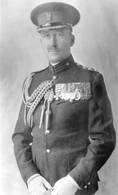
Major William Wasbrough Foster, DSO
Honorary Colonel of the 15th Field Brigade, Canadian Artillery from 1932 until 1938. He was a former member of the 2nd Battalion Canadian Garrison Artillery. In November 1914, he joined the 2nd Canadian Mounted Rifles. After distinguishing himself at the Somme and Vimy Ridge, he was promoted to command the 52nd Battalion in August 1917. He was a Major in the 2nd Canadian Mounted Rifles when awarded the Distinguished Service Order. The citation reads:
For conspicuous gallantry in action. He detailed two patrols, and himself led a third under heavy fire, and obtained most valuable information. Later, he carried out a successful attack and captured his objective. He displayed the greatest courage and initiative throughout (L.G. 29837)
He was also awarded a Bar to the DSO for which the citation reads:
For conspicuous gallantry and devotion to duty. When in command of the supporting battalion he personally led two companies of his unit in a flanking attack on some concrete strong points, containing several hostile machine guns. Owing to his personal example of gallantry, his tactical ability and effective leadership, the whole objective was gained with but small loss, and a critical situation was retrieved (L.G. 30482)
A second bar was awarded for the following:
For conspicuous gallantry and splendid leadership. After two unsuccessful attacks on a village he made a daring reconnaissance to locate enemy machine guns: and then having organised two raiding parties he led one of them personally; while the other made a feint attack on a flank. With his own party he accounted for several machine guns, and the eventual result of this third attack was the capture of the village, the defeat of an enemy counter attack, and the capture of 250 prisoners by his battalion. In the evening he handed over his advanced line to a relieving battalion. He rendered most valuable service. (L.G. 31043)
In addition to the Distinguished Service Order with two bars, Colonel Foster was also Mentioned in Despatches four times and awarded the Belgian Croix de Guerre and the French Croix de Guerre.
Honorary Colonel of the 15th Field Brigade, Canadian Artillery from 1932 until 1938. He was a former member of the 2nd Battalion Canadian Garrison Artillery. In November 1914, he joined the 2nd Canadian Mounted Rifles. After distinguishing himself at the Somme and Vimy Ridge, he was promoted to command the 52nd Battalion in August 1917. He was a Major in the 2nd Canadian Mounted Rifles when awarded the Distinguished Service Order. The citation reads:
For conspicuous gallantry in action. He detailed two patrols, and himself led a third under heavy fire, and obtained most valuable information. Later, he carried out a successful attack and captured his objective. He displayed the greatest courage and initiative throughout (L.G. 29837)
He was also awarded a Bar to the DSO for which the citation reads:
For conspicuous gallantry and devotion to duty. When in command of the supporting battalion he personally led two companies of his unit in a flanking attack on some concrete strong points, containing several hostile machine guns. Owing to his personal example of gallantry, his tactical ability and effective leadership, the whole objective was gained with but small loss, and a critical situation was retrieved (L.G. 30482)
A second bar was awarded for the following:
For conspicuous gallantry and splendid leadership. After two unsuccessful attacks on a village he made a daring reconnaissance to locate enemy machine guns: and then having organised two raiding parties he led one of them personally; while the other made a feint attack on a flank. With his own party he accounted for several machine guns, and the eventual result of this third attack was the capture of the village, the defeat of an enemy counter attack, and the capture of 250 prisoners by his battalion. In the evening he handed over his advanced line to a relieving battalion. He rendered most valuable service. (L.G. 31043)
In addition to the Distinguished Service Order with two bars, Colonel Foster was also Mentioned in Despatches four times and awarded the Belgian Croix de Guerre and the French Croix de Guerre.

Major David Neil Hossie, DSO
Battery Commander of the 85th Battery, 15th Brigade Canadian Field Artillery from 1922 to 1926. He served in the First World War with the Royal Field Artillery in France and Belgium from 10 May 1915 to 10 January 1916, Greek Macedonia, Siberia, Bulgaria etc from 11 January 1916 to 3 February 1919. He was Mentioned in Dispatches three times, awarded the Order of the White Eagle 4th Class. After the war he was called to the Bar of British Columbia in December 1919, practiced law with Davis, Hossie, Lett, Marshall & McLorg and at one time served as Chairman of the Vancouver General Hospital, named King's Counsel (KC) for British Columbia in 1932, deceased 1962.
Still searching for details on the awarding of the Distinguished Service Order.
Battery Commander of the 85th Battery, 15th Brigade Canadian Field Artillery from 1922 to 1926. He served in the First World War with the Royal Field Artillery in France and Belgium from 10 May 1915 to 10 January 1916, Greek Macedonia, Siberia, Bulgaria etc from 11 January 1916 to 3 February 1919. He was Mentioned in Dispatches three times, awarded the Order of the White Eagle 4th Class. After the war he was called to the Bar of British Columbia in December 1919, practiced law with Davis, Hossie, Lett, Marshall & McLorg and at one time served as Chairman of the Vancouver General Hospital, named King's Counsel (KC) for British Columbia in 1932, deceased 1962.
Still searching for details on the awarding of the Distinguished Service Order.
|
Major Walter Court Hyde, DSO
Enroled as a Lieutenant with 3rd Brigade Canadian Field Artillery at the outset of World War I. He was later promoted Acting Major and awarded the Distinguished Service Order. The citation for the award has yet to be found. He was also Mentioned in Despatches for another incident. He was posted to 68th Battery 16th Brigade Canadian Field Artillery North Russia Expeditionary Force where he was awarded the Order of St Stanislaus with Swords Second Class. On the conclusion of the War, he enroled with 2nd Montreal Regiment Royal Canadian Artillery, was President of the Royal Canadian Artillery Association in 1935 During World War II he rose to the rank of Brigadier and appointed Commander Royal Artillery 4th Canadian Armoured Division. |
|
Lieutenant-Colonel Alexander Thomas Ogilvie, DSO
Commanding Officer of 15th Brigade Canadian Field Artillery on 11 September 1916 when it embarked at Halifax destined for England. On 22 Jan 1917 the 15th was absorbed by the 14th Brigade Canadian Field Artillery. His citation reads: For conspicuous gallantry and ability on September 2nd, 1918, near Vis-en-Artois. he maneuvered his brigade from the extreme left of the corps front line into a forward position in support of the centre. He made a rapid reconnaissance of the new situation under heavy shell fire, and was in a position to cover the infantry with all his batteries before the former were in position to commence the attack. He was able, through his own reconnaissance and that of his F.O.O.'s to give the infantry brigadier much useful information, and through the day rendered very valuable support to the infantry. |
|
Lieutenant- Colonel Duncan Kent Todd, DSO, CD
Enlisted originally with the 15th Field Brigade, Canadian Artillery as a Lieutenant in 85th Battery from 1928 to 1930. He enlisted with the Royal Canadian Horse Artillery in Kingston from 1934 to 1939. In February 1942 he takes over command of the 1st Medium Regiment, RCA and takes the unit to Sicily and then on to North West Europe. After the war he was promoted Colonel in 1948 and appointed Commander Camp Borden and then Commandant Camp Petawawa before being appointed Military Attaché in Turkey 1951. Colonel Todd retired in Perthshire, Scotland. |
Lists
The following pages contain additional information relating to the 15th Field Artillery Regiment, RCA
Honours and Awards
Trophies
Commanding Officers and Regimental Sergeants Major
Honoraries
Battery Commanders and Battery Sergeants Major
Band Appointments
Nominal Roll
Guns of the Regiment
Memorial Page
The following pages contain additional information relating to the 15th Field Artillery Regiment, RCA
Honours and Awards
Trophies
Commanding Officers and Regimental Sergeants Major
Honoraries
Battery Commanders and Battery Sergeants Major
Band Appointments
Nominal Roll
Guns of the Regiment
Memorial Page
